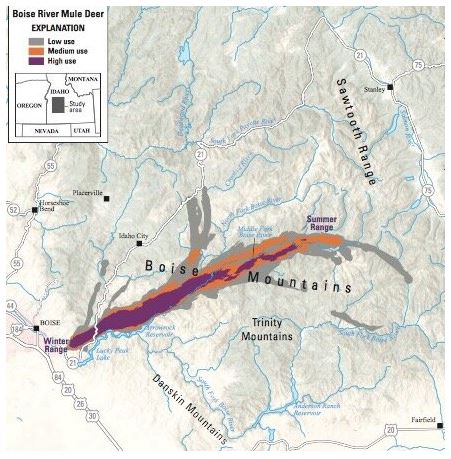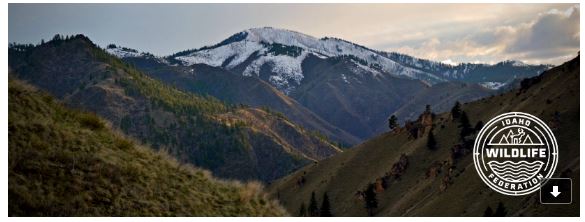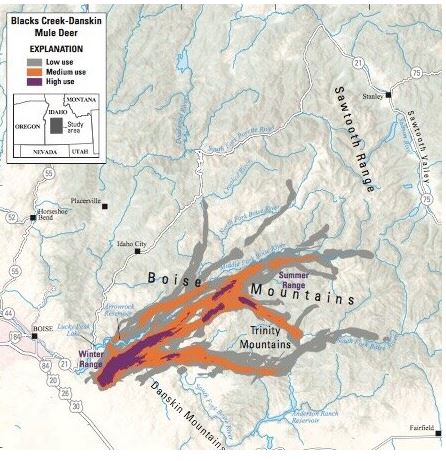OVERWHELMING SPORTSMAN OPPOSITION TO LUCKY PEAK TRAIL
This summer, sportsmen and women rallied together to oppose the Army Corps of Engineers’ plan to construct the Lake View Trail near Lucky Peak Reservoir and within the Boise River Wildlife Management Area. IWF led the charge the organize our community push back on a project that punches through critical mule deer wintering habitat. Of the total comments received, 92% voiced opposition to the construction of the 15-mile multi-use trail.
IWF and many of our affiliate organizations expressed substantial concern about the trail proposal, including the lack of analysis of impacts to the largest migrating mule deer herd in the state and their winter habitat, increased fire risk, and the lack of enforcement during seasonal closures.
The Idaho Department of Fish & Game and the Idaho Fish & Game Commission also strongly voiced these concerns and deserve our continued support. This landscape was set aside decades prior specifically for wintering ungulates and is managed under a specific Wildlife Management Area Plan. Sportsmen and women, the Department, and the Commission are standing together to protect these investments, and the future viability of the land, wildlife, and sporting opportunities.
Last week, IWF staff welcomed the release of additional scientific data that further validates these positions. The map below was published by the USGS as part of their Ungulate Migrations of the Western United States report and outlines migration routes and stopovers of Idaho’s Blacks Creek-Danskin mule deer herd, the largest migrating herd of mule deer in the state. The Army Corps’ proposed Lake View Trail would bisect the western edge of this critical habitat.
To further highlight the importance of the greater landscape, tack on this additional migration identified just on the other side Lucky Peak Reservoir, as seen in the map below.

Hunters have shown that we turn heads if we unify and speak as one voice – often it is uncomfortable and unfamiliar, but this is what determines the future of our wildlife and sporting heritage. While reports like the newly released USGS publication should impact land management decisions, it is still essential that we, as hunters, raise our voices of the value of these landscapes to decision makers. As the Army Corps inches closer to a decision, IWF will continue to closely monitor this process.
To read our original blog on this issue, click here. Be sure to check out the full USGS Report to view more of Idaho’s important migrations!
BREAKING: ARMY CORPS DECIDES “NO ACTION” ON LUCKY PEAK TRAIL
The Army Corps of Engineers has just issued a “No Action” decision for the proposed Lake View Trail in critical big game wintering habitat near Boise. The No Action alternative decision is a tremendous win in the eyes of sportsmen and women who have fought for generations to protect Idaho’s largest migrating mule deer herd from encroachment of development.
The Army Corps’ proposed Lake View Trail was a 15-mile multi-use trail near the shores of Lucky Peak Lake and in the Boise River Wildlife Management Area. Idaho Wildlife Federation opposed the trail and expressed significant concerns over the trail proposal’s location, lack of enforceable seasonal closures, fire risk, and direct conflicts with Boise River Wildlife Management Plan’s management directions. IWF, along with our conservation partners, including the Upper Snake River Tribes Foundation, Idaho Department of Fish & Game, and the Idaho Fish & Game Commission raised these points to the Corps over several months- and the Corps’ Lt. Col. Childers listened. The Corps cited that the decision to take no action at this time was due to “the very high value some stakeholders place on the ecosystem outputs provided by the existing habitat conditions and traditional significance of the area.”
“Idaho Wildlife Federation welcomes the Corps’ decision to forgo plans to construct the Lake View Trail. The trail, as proposed, brought significant risks to the landscape utilized by our state’s largest migrating mule deer herd and would have undermined generations of conservation efforts dating back to the 1940s” said Brian Brooks, Executive Director of Idaho Wildlife Federation. “We will continue leading efforts to address the needs of wildlife amidst a rapidly expanding population in Idaho.”
The hills just beyond Boise to the East make up the Boise River Wildlife Management Area; highlighted in this USGS report of major ungulate migrations of the Western US. From as early as 1943, this landscape has been set aside specifically to protect the last remaining wintering grounds for mule deer and elk that migrate upwards of 100 miles to summer feeding grounds near the Sawtooths. This data is critical to showcase the value of conserving winter range at the terminal end of these annual migrations.
“IWF owes a huge thank you to the sportsmen and women who spoke up in opposition during the public comment period,” said Garret Visser, IWF’s Conservation Program Coordinator. “Conservation wins don’t come easy. It takes a lot of work to educate folks on an issue and organize them to take action, but it’s all for nothing if no one takes the step to voice their values. This decision was made possible by our voices echoing all the way to the Army Corps’ desks in Walla Walla.”
92% of submitted public comments opposed the construction of the trail. “Those numbers are remarkable,” concluded Visser. “Wildlife conservation is still such a uniting issue.”
Check out the Army Corps’ decision here.


